1/ Oh hai Clinical Excellence Commission @NSWCEC. Looks like you wrote an IPAC Manual for Quarantine Hotels recommending air pressure differential limits without considering the implications. Would you like some assistance with that? THREAD... 

https://twitter.com/NSWCEC/status/1398156866862018569?s=20


2/ Allow me to introduce you to Bernoulli's Equation as it pertains to flow through an orifice. In this case, under and around a door. 

3/ Bernoulli's equation allows us to predict airflow from a pressure difference, and vice-versa. The Florida Energy Center tested various orifices for flow & pressure difference. ba-pirc.org/casestud/retur… Using these results I calculate a Cd of 0.71 for various slots. 

4/ Not wanting to be wrong, I confirmed this at home. I measured the gap dimensions under a bedroom door, the air pressure difference, the flow entering the room, and the average velocity across the bottom of the door into the hallway with a mini vane anemometer traverse. 





5/ For a 2.2 Pa positive pressure in the room relative to the hallway, the flow was 33.4 CFM (16 L/s) and average velocity 235 fpm (1.2 m/s) into the hall. I noticed at one edge the flow was reversed, entering the room. It was also much higher in the center.
6/ With the measured crack area and 2.2 Pa the calculated values are 16 L/s and 1.4 m/s, so the measurements match well with the model. The velocity measurement is difficult to make, especially with the reversed flow, so it makes sense it would be a bit lower. 

7/ Turning to @NSWCEC's IPAC manual, it has a cutoff of up+5 Pa pressure difference (room higher than corridor), where "the room has very low risk of particles leaving the room when the door is opened".
Except there is always a crack, usually by design, and air flows freely.
Except there is always a crack, usually by design, and air flows freely.

8/ The crack under the door is there for typical corridor positive-pressure makeup air. If an exhaust fan is running, the makeup air has to come from somewhere. Positive pressure in the hallway keeps odours in the suites and supplies fresh air.
9/ It turns out that average velocity is independent of the area. In the limit the crack may become sharper, affecting the discharge coefficient, but otherwise this chart shows the average air velocity through a crack for a Cd of 0.71. Why allow up to 5 Pa? 

10/ Shouldn't it be negative? A 3 Pa positive pressure still shoots air out into the hallway through a crack at 1.6 m/s. Why is that "low risk"? Here's an example from @drajm in a Perth hotel:
https://twitter.com/drajm/status/1357220141507911684?s=20
11/ I get it, this stems in part from the quarantine leak report which cited opening and closing of doors. Were differential pressures measured? Pressure is fundamental to airflow between zones.
https://twitter.com/DamianTheAussie/status/1397469819864162309?s=20
12/ If the door is very tightly sealed with a gasket you can achieve very little air flow (volume) and the pressure difference will likely *increase*. But sealing gets only a very short mention once. How likely will this be done? 

13/ Also, the door should only be completely sealed if it is compatible with the design of the building system. This is likely only for compartmentalization, where every suite has a dedicated supply and exhaust system and is air sealed from the rest of the building.
14/ Without compartmentalization the gap is needed for makeup air. With a gap, you need to ensure the suite is in negative pressure with continual exhaust.
15/ In typical hotels and apartments, opening windows messes with pressures and can cause all sorts of unpredictable airflow patterns.
16/ Here are recommended quarantine accommodation types, in order of preference, based on building science:
a) air-gapped
b) compartmentalized
c) negative pressure (with sealed windows).
a) air-gapped
b) compartmentalized
c) negative pressure (with sealed windows).

17/ Looking at the contributors to this document I think we have an idea why this guidance is missing out on the fundamentals of fluid mechanics and building science that we've known for decades. Is @NSWCEC unintentionally practicing professional engineering here? 

18/ There's many other problems with the NSW IPAC Manual for Quarantine Hotels that have been pointed out by others (cleaning is NOT an engineering control! gappy surgical masks instead of P2/N95 respirators for essential workers!) and I recommend heeding their advice.
19/ For further reading, I continue to add to a longer thread on the fundamentals of uncontrolled in air flow within buildings that can explain why there are outbreaks happening in apartment buildings as well as hotels, which have a similar design.
https://twitter.com/DavidElfstrom/status/1379814589395795975?s=20
20/ @CathNoakes summarizes this thread well: "It’s the continuous flow under the doors that probably matters more than the brief flow when a door is opened."
https://twitter.com/CathNoakes/status/1404131542394417157?s=20
21/ Overall the TooLongDidntRead summary is that because IPAC doesn't understand fluid dynamics they permit for airflow in the wrong direction that can lead to a repeat of transmission events within quarantine, which their guidance is trying to avoid in the first place.
22/ December update on this topic of pressure-driven under-door air flow from @CathNoakes
https://twitter.com/CathNoakes/status/1466924152137392135?t=nyFKugVixHTbCL6tDJtVlg&s=19
23/ Taiwan. Be like Taiwan.
https://twitter.com/DavidElfstrom/status/1471497712876986377?t=NsZJukP8LMRzK4SO9CmVug&s=19
• • •
Missing some Tweet in this thread? You can try to
force a refresh


![States high levels of CO2 and other contaminants ... can contribute to [list of five health effects, such as headaches, fatigue, difficultly concentrating], says CO2 should be below 1000 ppm, then says (incorrectly) that health effects from CO2 occur at levels above 5000 ppm. No, those effects can occur below 5000 ppm. It also states the CO2 concentrations do not indicate a risk of infectious disease transmission in a space. No, ASHRAE's position statement on CO2 states that elevated CO2 concentrations CAN reflect higher risk. Obviously, because it indicates poor ventilation, which IS an i...](https://pbs.twimg.com/media/GO6z_36WQAI7_mj.jpg)







